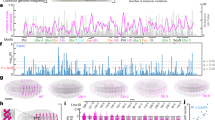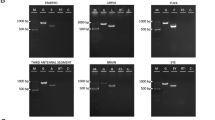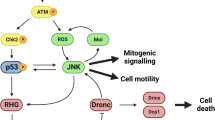Abstract
Vertebrate genomes contain an extensive family of genes possessing varying degrees of homology to the v-src oncogene. Most src-related proteins identified to date are intracellular and membrane-associated, although some are transmembrane proteins and function as receptors for peptide growth factors1–6. Three Drosophila gene sequences related to the v-src gene have been identified, each exhibiting a high degree of homology to one or more of the src-family members encoding an intracellular protein7–9. We have isolated a panel of cloned Drosophila sequences exhibiting weak v-src hybridization and were interested to determine whether any members of this group represented homologues of additional known src-family genes, especially those functioning as growth factor receptors. As we report here, four of these clones, representing overlapping portions of the same genomic segment, hybridized preferentially with the v-erb-B oncogene and were further characterized. The deduced amino-acid sequence from a portion of this Drosophila genomic segment is 77% homologous to the kinase domain of human epidermal growth factor (EGF) receptor, a substantially greater degree of homology than was observed with any other known src-family member. By hybridization with a human EGF receptor complementary DNA clone probe10, we demonstrate that the same genomic segment showing homology with the kinase domain also contains sequences related to the extracellular domain of the EGF receptor gene.
This is a preview of subscription content, access via your institution
Access options
Subscribe to this journal
Receive 51 print issues and online access
$199.00 per year
only $3.90 per issue
Buy this article
- Purchase on Springer Link
- Instant access to full article PDF
Prices may be subject to local taxes which are calculated during checkout
Similar content being viewed by others
References
Bishop, J. M. A. Rev. Biochem. 52, 301–354 (1983).
Buhrow, S. A., Cohen, S. & Stavros, J. V. J. biol. Chem. 257, 4019–4022 (1982).
Ek, B., Westermark, B., Wasteson, A. & Heldin, C.-H. Nature 295, 419–420 (1982).
Nishimura, J., Huang, J. S. & Deuel, T. F. Proc. natn. Acad. Sci. U.S.A. 79, 4303–4307 (1982).
Cooper, J. A., Bowen-Pope, D. F., Raines, E., Ross, R. & Hunter, T. Cell 31, 263–273 (1982).
Downward, J. et al. Nature 307, 521–527 (1984).
Hoffmann, M. F., Fresco, L. D., Hoffman-Falk & Shilo, B.-Z. Cell 35, 393–401 (1983).
Simon, M. A., Kornberg, T. B. & Bishop, J. M. Nature 302, 837–839 (1983).
Wadsworth, S. C., Madhavan, K. & Bilodeau-Wentworth, D. Nucleic Acids Res. (submitted).
Ullrich, A. et al. Nature 309, 418–425 (1984).
Southern, E. M. J. molec. Biol. 98, 503–517 (1975).
Yamamoto, T. et al. Cell 35, 71–78 (1983).
Vennstrom, B. & Bishop, J. M. Cell 28, 135–143 (1982).
Barker, W. C. & Dayhoff, M. O. Proc. natn. Acad. Sci. U.S.A. 79, 2836–2839 (1982).
Shozo, S. et al. Proc. natn. Acad. Sci. U.S.A. 78, 848–851 (1981).
Zoller, M. J. & Taylor, S. S. J. biol. Chem. 254, 8363–8368 (1979).
Maniatis, T. et al. Cell 15, 687–701 (1978).
Denhardt, D. T. Biochem. biophys. Res. Commun. 23, 641–646 (1966).
Sanger, F., Nicklen, S. & Coulson, A. R. Proc. natn. Acad. Sci. U.S.A. 74, 5463–5467 (1977).
Pustell, J. & Kafatos, F. C. Nucleic Acids Res. 10, 4765–4782 (1982).
Hampe, A., Laprevotte, I., Gailbert, F., Fedele, L. A. & Sherr, C. J. Cell 30, 775–785 (1982).
Shibuya, M. & Hanafusa, H. Cell 30, 787–795 (1982).
Schwartz, D. E., Tizard, R. & Gilbert, W. Cell 32, 853–869 (1983).
Kitamura, N., Kitamura, A., Toyoshima, K., Hirayama, Y. & Yoshida, M. Nature 297, 205–208 (1982).
Hampe, A., Gobet, M., Sherr, C. J. & Gailbert, F. Proc. natn. Acad. Sci. U.S.A. 81, 85–89 (1984).
Madhavan, K., Bilodeau-Wentworth, D. & Wadsworth, S. C. Molec. cell. Biol. 5, 7–16 (1985).
Holmgren, R., Livak, K., Morimoto, R., Freund, R. & Meselson, M. Cell 18, 1359–1370 (1979).
Author information
Authors and Affiliations
Rights and permissions
About this article
Cite this article
Wadsworth, S., Vincent, W. & Bilodeau-Wentworth, D. A Drosophila genomic sequence with homology to human epidermal growth factor receptor. Nature 314, 178–180 (1985). https://doi.org/10.1038/314178a0
Received:
Accepted:
Issue Date:
DOI: https://doi.org/10.1038/314178a0
This article is cited by
Comments
By submitting a comment you agree to abide by our Terms and Community Guidelines. If you find something abusive or that does not comply with our terms or guidelines please flag it as inappropriate.



